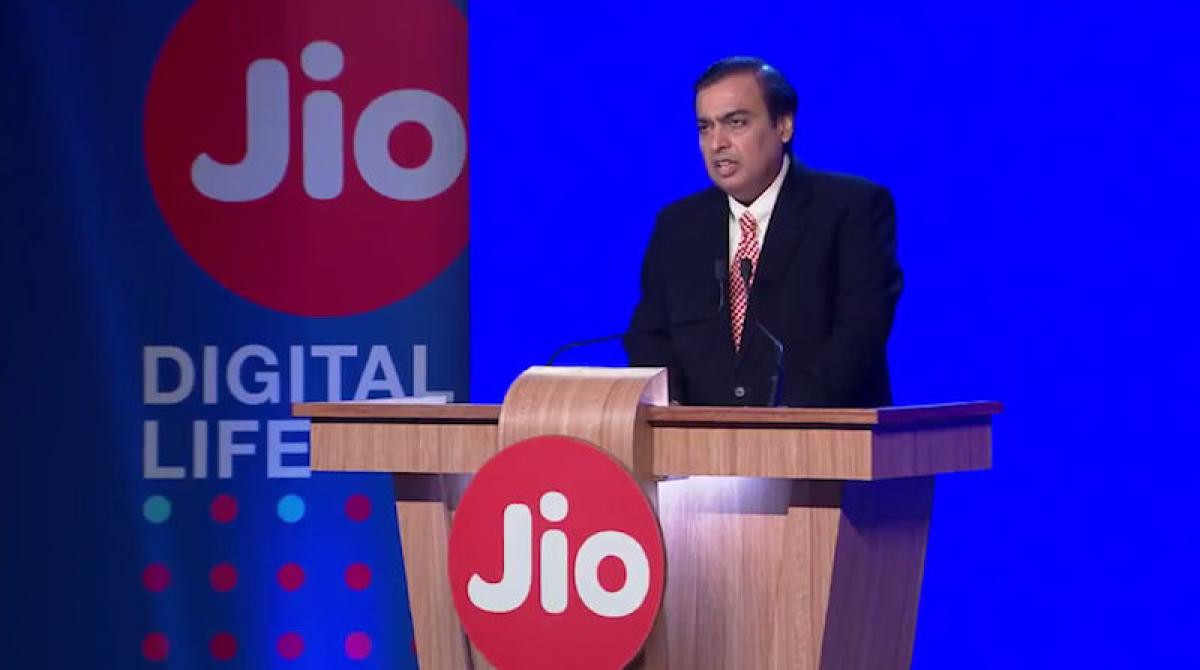Live
- Film actor Mohan Babu knocks High Court doors. Requests for anticipatory bail
- Allu Arjun Seeks Lunch Motion; Court Hearing Scheduled for 2 PM Today
- Vijayawada hosts Swarnandhra Vision-2047 Program to foster development in AP
- World Bank okays loan for new project to boost earnings of UP farmers
- Zomato gets GST tax demand notice of Rs 803 crore
- Atul Subhash suicide: No arrests made yet, says Bengaluru Police Commissioner
- Indian agrochemicals sector to see 7-9 pc growth next fiscal: Report
- SC refers to CJI Cong leader’s petition for verification of EVMs used in Haryana polls
- To become the youngest world champion is truly a great feat: Gill congratulates Gukesh
- Case Filed Against Allu Arjun Under Four Sections
Just In

Jio has acquired more than 125 million customers since its launch last year, primarily by offering free voice and unlimited data plans, but a further expansion of its customer base hinges largely on the availability of entry-level 4G-enabled devices.
At first glance, Indian telecoms upstart Jio's bet on 'free' internet-enabled phones to win over poorer customers is a near-fatal blow for low-end handset makers, most already struggling with paper-thin margins on some of the world's cheapest devices.
But industry executives and analysts say Jio's crossover feature phone - not quite a smartphone, not quite a no-frills handset - could, in fact, be a boon to the lower end of the market and suppliers that feed it, creating a new in-between category and getting more people online for the first time.
The JioPhone, they say, creates a new phone segment aimed at millions of low-paid Indians, currently caught between basic, calls-and-text devices and fancier smartphones.
Reliance Industries, led by India's wealthiest man Mukesh Ambani, waded into India's cut-throat telecoms industry last year with its $30 billion bet on Jio, upending the sector with its cheap smartphones and data plans.
Last week, it announced a new phone, which allows digital payments and will come effectively free. Buyers can get a device for a refundable fee of 1,500 rupees ($23.30).
Currently over 60 per cent of India's roughly 750 million mobile users use phones that allow only calls and basic texts, making so-called feature phones the country's single largest segment. But many will soon move up the chain.
"The concept of 4G feature phones is not new, and most Indian firms have already done their R&D," said Jaipal Singh, analyst with tech research firm IDC. "Brands such as Micromax, Lava, Intex and Karbonn will launch similar devices to either compete or partner with Jio."
Micromax, one of India's largest brands, said it was working on a 4G feature phone that would rival Jio's compromise offering. Lava, which launched India's first low-cost, 4G-enabled phone this year - selling for about $50 - said it could launch more if there was demand.
Samsung Electronics, the largest player in India thanks to its range of offerings, from high-end smartphones to basic $15 handsets, expects the new offerings to expand the whole market and "boost Samsung's mobile phone sales in future".
Not Just Business
But the industry will still face tough times for now, as Jio's deep pockets still squeeze rivals - and its suppliers.
"The low-cost JioPhone will place pressure on Indian feature phone leaders such as Samsung, Intex and Lava, and make life harder for ambitious new entrants like HMD," said Neil Mawston, an executive director at tech research firm Strategy Analytics.
HMD Global, a Finnish company that owns the rights to the Nokia phone brand, this year launched a revamped version of the Nokia 3310, which retails in India for about $50.
A senior Reliance executive said the company plans to have 5 million phones available each week, but is concerned its supply chain may not be able to keep up with demand.
Ambani's bet is not just business. The deal is also a boost for two of Prime Minister Narendra Modi's key campaigns: "Digital India", which aims to get more Indians online, and "Make in India", to encourage local manufacturing.
The Reliance executive said it aims to have all the assembly of its JioPhone devices done in India by the year-end, by the likes of Foxconn Technology Co and Flextronics Corp.
Smartphones remain popular in India's cities, but the JioPhone will allow Jio to connect millions of new clients in smaller towns and the countryside, who prefer a simpler user interface, local language scripts and chunkier batteries, said Tarun Pathak of Counterpoint Research.
The JioPhone will give them a first taste of high-speed web browsing and is likely to gradually boost online shopping in the world's fastest-growing internet services market, analysts said.
Reliance plans to weave NFC (near field communication) - a wireless technology that allows two devices to connect - in the JioPhone later this year, a move likely to accelerate the adoption of digital payments.
Jio has acquired more than 125 million customers since its launch last year, primarily by offering free voice and unlimited data plans, but a further expansion of its customer base hinges largely on the availability of entry-level 4G-enabled devices.

© 2024 Hyderabad Media House Limited/The Hans India. All rights reserved. Powered by hocalwire.com







